| enter keyword to search: |
|
Images db
|
|
|
Articles db
|
|
|
|
|
|
|
|
|
Located on the eastern bank of the enormous artificial lake Parakrama, Polonnaruwa, the ancient capital from around 1070 AD, was originally enclosed by three concentric walls and filled with parks and gardens. The ruins are scattered over an extensive area of woodland, with cows kept as ‘lawnmowers’. At its centre lay the Citadel, the royal residences of successive kings. To the north lies the Quadrangle, the city’s religious heart and further north buildings like the Rankot Vihara Lankatilaka and the famous Buddha statues of the Gal Vihara.
Polonnaruwa |
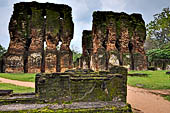
|
Royal Palace Group
the Royal Palace Group, known also as the Citadel, is an area of remains of various buildings used as royal residence. The area is surrounded by walls. Of the original seven storeys of the Royal Palace, (refer to the reconstruction in the museum) only three brick storeys have survived. The holes in the walls were for floor beams, while the vertical grooves up to the first floor would have held wooden pillars.
Just east the base of the Council Chamber, banded with friezes of dwarfs, lions and galumphing elephants. The sumptuous stone stairways are embellished with makara balustrades and topped with two lions. The columns are inscribed with the king's councillors names.
Further east the Royal Baths (Kumara Pokuna) fed by two spouts carved with eroded makaras. Next to here stands the royal bathhouse a two-tiered base decorated with lions, note the moonstone of the upper level.
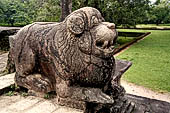
|
Polonnaruwa
|
Shiva Devale
the Shiva Devale no. 1 (xii c) is one of temples at Polonnaruwa dedicated to either Vishnu or Shiva and built the Hindu invaders. The temple is made of finely cut stone, fitted together without the use of mortar. Around the back of the shrine stand tiny statuettes of a couple of venerable and heavily bearded figures which possibly represent Agni, the pre-Aryan Hindu god of fire.
Polonnaruwa |
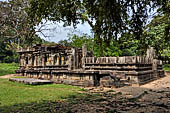
|
The Quadrangle
the Quadrangle, or more properly Dalada Maluwa (‘Terrace of the Tooth Relic’ since the Sacred Relic was formerly housed here) is a walled enclosure built on a raised terrace.
The Quadrangle is dominated by the magnificent Vatadage, a general architectural term indicating the unique Sri-Lanka version of the stupa. The one of Polonnaruwa is generally believed to be the best example of a vatadage in Sri Lanka. The plan comprises a lower circular platform with a single entrance on the north. The shrine itself sits on a second upper platform accessed by four ornate stone stairways, aligned with the cardinal points, and enclosed by a round brick wall. In the interior of the temple the main stupa is presided over by four statues of meditating Buddha. The outer brick wall, preserved in places to its full eight, displays friezes of lions and dwarfs and an outer rows of stone columns which would once have supported the roof. The stone stairways leading from the lower terrace to the shrine are the most remarkable feature of this circular temple, sculptural masterpieces decorated with dwarfs lions and makaras and magnificent guardstones with a seven-hooded Nagaraja upholds an elaborate floral stem and a pot of plenty, attended by darfs (ganas) at his feet. The moonstones, among the finest in the city, displays a procession of geese, elephants and horses in the inner band.
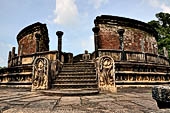
|
Polonnaruwa
|
Opposite the Vatadage stand the remains of the Hatadage, on the right of the entrance a long inscription says that king Nissankamalla built the building. The Sacred Tooth Relic may have been placed here for a time, it now houses three Buddha statues. A weathered frieze on the wall with representation of dancers. Generally absent from Polonnaruwa the lion can be seen in the moonstone at the Hatadage. The Gal Pota (‘Book of Stone’), an enormous slab of granite, some nine metres long, covered in a densely inscribed inscription of of Nissankamalla king. On the South end of the stone a carving of Lakshmi being given a shower by two elephants. The Satmahal Prasada (‘Seven-storey temple’) a strange seven stepped pyramid unique in Sri Lanka, few heavily eroded stucco figures decorate its walls.
Of the Atadage, one of the oldest structures in the city, it remains some finely carved pillars and door frames; a blackened Buddha statue stands in the centre. Next to the Atadage are the remains of an image house.
The Lotus Mandapa (Latha-Mandapaya) with a latticed stone fence reminiscent of a Buddhist Railing and very unusual sinuous stone pillars shaped as bent lotus buds with in the centre a tiny dagoba. In front of the Lotus Mandapa stands an armless Bodhisattva statue.
The Thuparama, an exceptionally large and well-preserved gedige (image house). The shrine contains eight beautiful old standing and seated limestone Buddhas. Beneath the scaffolding, the exterior walls are decorated with the South Indian-style niches and window frames which can be found on a number of other buildings.
Polonnaruwa |
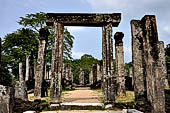
|
Rankot vihara
Rankot Vihara is an immense red-brick dagoba, although smaller of those of Anuradhapura in imitation of which it was built. Around it there are small brick shrines, vahalkadas, placed at the four cardinal points.
Lankatilaka and Kiri Vihara
At the heart of the Alahana Pirivena (‘Monastery of the Cremation Grounds’), the Lankatilaka (‘Ornament of Lanka’) consists of a huge shrine containing a 14m standing Buddha filling the entire space within the shrine. The entrance is approached by two sets of steps, Nagini images decorates the inner surface of the balustrade. The exterior walls are decorated with architectural bas reliefs and tall and slender recessed window split vertically by a finely-decorated square pillar.
Kiri Vihara is the best preserved of Polonnaruwa’s dagobas – ‘kiri’ means milk, referring to the white lime plaster that covers the building almost perfectly preserved after seven hundred years in the jungle. As at the Rankot Vihara, Kiri Vihara features four 'vahalkadas' and unusual brick shrines around its base.
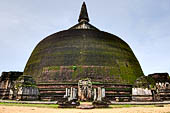
|
Polonnaruwa
|
Gal Vihara
Gal Vihara (‘Stone Shrine’ also known as the 'Kalugal Vihara', or 'Black Stone Shrine') represents the pinnacle of Sri Lankan rock sculpture. The four Buddha statues here, all carved from the same massive granite outcrop, formed part of a monastery complex. Each statue would originally have been housed in its own enclosure (note the holes in the rock), sadly today they are protected with ugly metal shelters which detract massively from the atmosphere of the place and keeps the statues in a permanent twilight.
The 14m long reclining Buddha in paranirvana mudra is especially beautiful (note the closed eyes and the left knee slightly flexed so that the toes of the two feet are not aligned: the upper foot is slight drawn back). Note also the ushnisha, the small protuberance on the top of the head, denoting the Buddha superior mental powers. Next to it the 7m standing Buddha with the unusual position of its arms and subtle bend at the waist his turned-out left foot is believed to be portrayed in the second week after Enlightenment.
The smaller seated Buddha is the earliest statue at Gal Vihara (x century), kept behind a metal grille and fibreglass shield, is is placed in a artificial cave cut out of the rock with in the background an arch modelled after the one at Sanchi (India) and other deities.
The larger Buddha seated in Samadhi is a masterpiece of Sri Lankan Buddhist sculpture. The Buddha is in deep meditation sitting on a seat adorned with lions and thunderbolts. There is a halo round his head.
Polonnaruwa |
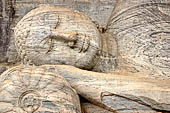
|
Tivanka-patamaghara Image House and lotus pond.
The unusual lotus pond formed from five concentric rings of stone carved in the shape of lotus petals. Along with the lotus pond, the Tivanka-patamaghara, the word Tivanka ‘thrice-bent’ refers to the headless Buddha image kept inside. Inside this large and squarish gedige, there are considerable traces of precious 12th-century wall paintings in their original form. Paintings include jataka stories and scenes from Mahamaya's dream. Restoration work continues inside and out.
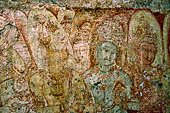
|
Polonnaruwa
|
| |
|
|
 |
|
|



